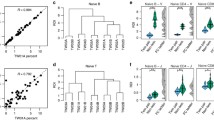Abstract
Twenty-five congenic mouse strains differing at distinguishable minor (non-H−2) histocompatibility loci were paired in 71 different combinations. F1 offspring were used as skin-graft donors for more than 4000 recipients to test whether immune responses to parental strain antigens were statistically independent. Thirty-four (48 percent) of the 71 combinations were predicted adequately by an independent response hypothesis. A simple additive model was consistent with 39 (55 percent) of the observed responses, although 18 of these were among those in agreement with the independent hypothesis. A synergistic response faster than that predicted by either the independent or additive response model was seen in 12 (17 percent) of the combinations. The remaining 5 percent were not well described by any of these models. No strain was represented with unusual frequency among those involved in synergistic interactions.
Similar content being viewed by others
References
Bailey, D. W.: Histoincompatibility associated with the X chromosome in mice.Transplantation 1: 70–74, 1963
Bailey, D. W.: Cumulative effect or independent effect?Transplantation 11: 419–421, 1971
Bailey, D. W.: Genetics of histocompatibility in mice. I. New loci and congenic lines.Immunogenetics 2: 249–256, 1975
Bailey, D. W. and Usama, B.: A rapid method of grafting skin on tails of mice.Transplant. Bull. 7: 424–425, 1960
Burnet, F. M.:The Clonal Selection Theory of Acquired Immunity. Cambridge University Press, New York, 1959
Graff, R. J., Silvers, W. K., Billingham, R. E., Hildemann, W. H., and Snell, G. D.: The cumulative effect of histocompatibility.Transplantation 4: 605–617, 1966
McKhann, C. F.: Regional lymph node response to skin grafts between strains of mice differing by strong and weak histocompatibility antigens.J. Surg. Res. 1: 294–298, 1961
McKhann, C.F.: Additive effects of multiple weak incompatibilities in transplantation immunity.Nature 201: 937–938, 1964
Pross, H. F. and Eidinger, D.: Antigenic competition: A review of non-specific antigen induced suppression.Adv. Immunol. 18: 133–168, 1974
Rosenau, W. and Horwitz, C.: Graft rejections in paternal to F1 hybrid and reciprocal hybrid grafts indicating a histocompatibility gene on the mouse X chromosome.Lab. Invest. 18: 298–303, 1968
Siegel, S.:Non-parametric Statistics for the Behavioral Sciences. McGraw-Hill, New York, 1956
Snedecor, G. W. and Cochran, W. F.:Statistical Methods, p. 124, Iowa State Univ. Press, Ames, 1967
Wolman, M., Bleiberg, I., and Leibovici, J.: Histological criteria for immunological rejection of mouse skin homografts.J. Pathol. 122: 1–7, 1977
Author information
Authors and Affiliations
Rights and permissions
About this article
Cite this article
Johnson, L.L., Bailey, D.W. & Mobraaten, L.E. Genetics of histocompatibility in mice. Immunogenetics 11, 363–372 (1980). https://doi.org/10.1007/BF01567803
Received:
Revised:
Issue Date:
DOI: https://doi.org/10.1007/BF01567803




